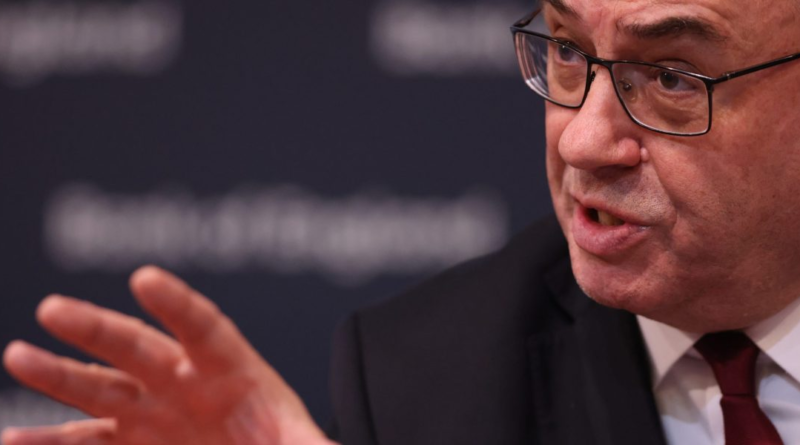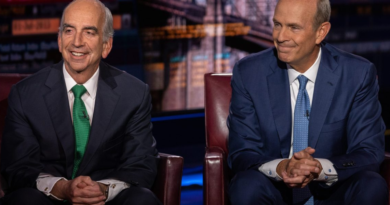U.K. inflation drops to 2.3%, but interest rate cuts aren’t expected until November
Stronger-than-expected British inflation prompted traders to sharply pare back bets on interest rate cuts and denied Prime Minister Rishi Sunak a totemic economic victory.
The Consumer Prices Index rose 2.3% from a year ago in April, the Office for National Statistics said on Wednesday, compared with 2.1% forecast by economists. While the data put the Bank of England 2% inflation target within reach and was the lowest level since a cost-of-living began to take hold almost three years ago, it was at the upper end of what economists had been anticipating.
Investors unwound bets on easing by the BOE, almost eliminating the chance of a June rate cut, which had been in play as recently as Tuesday. Traders now aren’t fully pricing in the first move by the central bank until November.
The pound rose its strongest level against the euro in more than two months as traders increasingly see a greater chance of the BOE taking longer to start easing than the European Central Bank. ECB President Christine Lagarde told Ireland’s RTE on Tuesday that a June cut was probable.
Economists in the UK zeroed-in on services inflation, which was little changed at 5.9% as price growth remained strong in the hospitality sector. The central bank, which is watching the number closely for signs of domestic inflationary pressures, had expected a reading of 5.5%. A core gauge of prices that excludes volatile food and energy costs fell to 3.9% from 4.2%.
“The higher-than-expected readings for both headline and services inflation in April are enough to scupper the chances of a June rate cut from the Bank of England,” Bloomberg economists Dan Hanson and Ana Andrade wrote in a note. “It now looks likely the easing cycle will begin in August.”
Both Sunak’s Conservatives and the opposition Labour Party seized on the data in an effort to set the narrative and prove their grasp on voters’ concerns as they gird for an election expected in the second half of the year. Less optimistic market bets on rate cuts will likely slow a reduction in mortgage costs that have become a symbol of the economic pressures on British households.
Sunak, who made reducing inflation a key goal for his first year in office, hailed the data as evidence that price growth was “back to normal,” adding that “brighter days are ahead.” Labour’s would-be chief Treasury secretary Darren Jones, however, told Bloomberg Television that the failure to hit the CPI target showed it was “not game over” yet for high inflation in the UK.
The year-on-year decline in price growth was largely driven by a 12% drop in the UK’s energy price cap, a mechanism designed to protect consumers from sharp moves in natural gas and electricity costs. April is a crucial month because many bills, such as mobile phone contracts, impose annual increases in that month.
“There was another large fall in annual inflation led by lower electricity and gas prices, due to the reduction in the Ofgem energy price cap,” said Grant Fitzner, chief economist at the ONS. “Food price inflation saw further falls over the year. These falls were partially offset by a small uptick in petrol prices.”
The upside surprise will increase the focus on May wage and inflation data due out in the days before the BOE’s Monetary Policy Committee meets on June 20. The nine-member panel has stressed the importance of such indicators in determining whether underlying price pressures have eased enough.
The BOE has signaled that it may cut interest rates this summer, if price pressures cool as expected. On Tuesday, BOE Governor Andrew Bailey had said during an appearance in London that he anticipated “quite a drop” in April’s inflation to “much nearer to target than it was before,” adding that he hadn’t seen the figure.
While the first batch of jobs data last week showed more signs that the labor market is loosening, wage growth remained stubbornly elevated at 6% — levels the BOE sees as too high to keep inflation down sustainably. It means that the second round of labor market figures due just over a week before the BOE decision is seen as crucial to the thinking of rate-setters.
Separate data on Wednesday showed that input prices for producers fell 1.6% compared to a year earlier, potentially pointing to easing inflation pressures in the pipeline for consumers. However, factory gate prices rose 1.1%, the strongest rate in almost a year.
“Falling inflation closes in on Bank of England’s target but may not be enough to sway an early rate cut,” said Yael Selfin, chief economist at KPMG UK. “This may still not be enough to convince more cautious MPC members to commit to a rate cut in June.”




